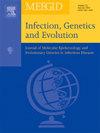Rapid confirmation of autochthonous origin in suspected cases of melioidosis from French overseas departments in the Caribbean and the Indian Ocean by PCR-high resolution melting (HRM) analysis
IF 2.6
4区 医学
Q3 INFECTIOUS DISEASES
引用次数: 0
Abstract
Burkholderia pseudomallei, a soil-borne bacterium that causes melioidosis, endemic in South and Southeast Asia and northern Australia, is now emerging in new regions. Since the 1990s, cases have been reported in French overseas departments, including Martinique and Guadeloupe in the Caribbean, and Reunion Island and Mayotte in the Indian Ocean, suggesting a local presence of the bacterium. Our phylogenetic analysis of 111 B. pseudomallei genomes isolated worldwide, including three strains from Martinique, revealed distinct geography-specific clades for Africa, the Americas, Asia and Australasia. Single nucleotide polymorphisms (SNP) that define clade branches in the phylogeny were identified; we selected those specific to three regions relevant to the French overseas departments: the Indian Ocean, the Americas and a unique subset specific to Martinique. Three SNP markers (one per region) were used to develop a PCR-high resolution melting tool to discriminate between local and imported strains in each region. Blind tests on B. pseudomallei strains from French patients, from overseas departments and mainland France, were used for validation. Our method accurately predicted the geographic origin of the patient as recorded from the patient travel history and/or from the multilocus sequence typing data. This rapid typing method, which allows timely identification of local cases and targeted public health interventions, is particularly valuable in the French overseas departments where melioidosis is emerging and regulatory constraints limit the handling of B. pseudomallei. Although initially tailored to specific regions, this tool can be adapted for use in other areas to support local epidemiological surveillance of melioidosis.
用聚合酶链反应-高分辨率融化(HRM)分析快速确认来自加勒比海和印度洋法国海外省的疑似类鼻疽病例的本土来源
伪氏伯克霍尔德菌是一种引起类鼻疽病的土壤传播细菌,在南亚和东南亚以及澳大利亚北部流行,现在正在新的地区出现。自20世纪90年代以来,法国的海外省份也报告了病例,包括加勒比海的马提尼克岛和瓜德罗普岛,以及印度洋的留尼汪岛和马约特岛,这表明这种细菌在当地存在。我们对世界各地分离的111株假马勒B.基因组进行了系统发育分析,其中包括来自马提尼克岛的3株菌株,揭示了非洲、美洲、亚洲和大洋洲不同的地理特异性分支。确定了在系统发育中定义进化支的单核苷酸多态性(SNP);我们选择了与法国海外部门相关的三个特定区域:印度洋、美洲和马提尼克岛特有的一个独特子集。使用3个SNP标记(每个区域1个)建立pcr高分辨率熔化工具,以区分每个区域的本地菌株和输入菌株。对来自法国患者、海外科室和法国本土的假假麦氏杆菌进行盲法检测进行验证。我们的方法根据患者旅行史和/或多位点序列分型数据准确预测了患者的地理来源。这种快速分型方法可以及时识别当地病例并进行有针对性的公共卫生干预,在类鼻疽病正在出现且监管限制限制处理假芽孢杆菌的法国海外部门尤其有价值。虽然最初是为特定区域量身定制的,但该工具可用于其他地区,以支持当地对类鼻疽病的流行病学监测。
本文章由计算机程序翻译,如有差异,请以英文原文为准。
求助全文
约1分钟内获得全文
求助全文
来源期刊

Infection Genetics and Evolution
医学-传染病学
CiteScore
8.40
自引率
0.00%
发文量
215
审稿时长
82 days
期刊介绍:
(aka Journal of Molecular Epidemiology and Evolutionary Genetics of Infectious Diseases -- MEEGID)
Infectious diseases constitute one of the main challenges to medical science in the coming century. The impressive development of molecular megatechnologies and of bioinformatics have greatly increased our knowledge of the evolution, transmission and pathogenicity of infectious diseases. Research has shown that host susceptibility to many infectious diseases has a genetic basis. Furthermore, much is now known on the molecular epidemiology, evolution and virulence of pathogenic agents, as well as their resistance to drugs, vaccines, and antibiotics. Equally, research on the genetics of disease vectors has greatly improved our understanding of their systematics, has increased our capacity to identify target populations for control or intervention, and has provided detailed information on the mechanisms of insecticide resistance.
However, the genetics and evolutionary biology of hosts, pathogens and vectors have tended to develop as three separate fields of research. This artificial compartmentalisation is of concern due to our growing appreciation of the strong co-evolutionary interactions among hosts, pathogens and vectors.
Infection, Genetics and Evolution and its companion congress [MEEGID](http://www.meegidconference.com/) (for Molecular Epidemiology and Evolutionary Genetics of Infectious Diseases) are the main forum acting for the cross-fertilization between evolutionary science and biomedical research on infectious diseases.
Infection, Genetics and Evolution is the only journal that welcomes articles dealing with the genetics and evolutionary biology of hosts, pathogens and vectors, and coevolution processes among them in relation to infection and disease manifestation. All infectious models enter the scope of the journal, including pathogens of humans, animals and plants, either parasites, fungi, bacteria, viruses or prions. The journal welcomes articles dealing with genetics, population genetics, genomics, postgenomics, gene expression, evolutionary biology, population dynamics, mathematical modeling and bioinformatics. We also provide many author benefits, such as free PDFs, a liberal copyright policy, special discounts on Elsevier publications and much more. Please click here for more information on our author services .
 求助内容:
求助内容: 应助结果提醒方式:
应助结果提醒方式:


